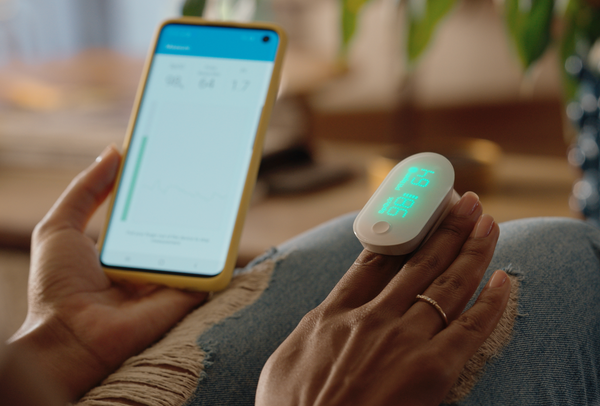Support
- iHealth COVID-19 Antigen Rapid Test
- iHealth Thermometer (PT3)
- Wireless Smart-Gluco Monitoring System
- Align Glucose Meter (BG1)
- Clear Blood Pressure Monitor (BPM1)
- Feel Wireless Blood Pressure Monitor (BP5)
- Track Connected Blood Pressure Monitor (550BT)
- Ease Blood Pressure Monitor (BP3L)
- View Wireless Blood Pressure Wrist Monitor (BP7S)
- Sense Wireless Blood Pressure Wrist Monitor (BP7)
- Core Wireless Body Composition Scale (HS6)
- Wireless Body Analysis Scale (HS5)
- Lite Wireless Scale (HS4/HS4S)
- Wireless Scale (HS3)
- Wireless Pulse Oximeter (PO3)
- Wave Activity, Swim, and Sleep Tracker (AM4)
- Wireless Activity and Sleep Tracker (AM3)
- Shipping and Returns
Company
- About Us
- Partners
Wireless Pulse Oximeter
Device Compatibility
Apple iOS devices (requires iOS version 8.0 or higher)
- iPhone 7/7 Plus
- iPhone 6S/6S Plus
- iPhone 6/6 Plus
- iPhone 5S/5C
- iPhone 5
- iPhone 4S
- iPad Air 2
- iPad Air
- iPad Mini 3
- iPad Mini 2
- iPad Mini
- iPad Pro
- iPad 4th Gen
- iPad 3rd Gen
- IPod Touch 6th Gen
- iPod Touch 5th Gen
Android devices (requires operating system 4.0 or later)
- Samsung Galaxy S7/S7 Edge
- Samsung Galaxy S6/S6 Edge
- Samsung Galaxy S5
- Samsung Galaxy S4
- Samsung Galaxy S3
- Samsung Galaxy Note3
- Samsung Galaxy Note2
- HTC One M7
- LG Nexus 4
- LG Nexus 5
- Motorola Nexus 6
FAQ
Troubleshooting
Setup and Usage
Product Information
Oxygen saturation (SpO2) is a measurement of how much oxygen your blood is carrying as a percentage of the maximum it could carry. For a healthy individual, the normal SpO2 should be between 96% to 99%. High altitudes and other factors may affect what is considered normal for a given individual.
Learn more about monitoring your oxygen levels with our iHealth Air Pulse Oximeter. Visit the Product Page for details.
In this post, we will cover what SpO2 is, how it is measured and factors that affect its measurement.
Overview:
What is SpO2?
There needs to be a particular amount of oxygen present in the blood at all times, or the body cannot function properly. SpO2, or oxygen saturation, is a measure of the amount of oxygen-carrying hemoglobin in the blood compared to the amount of hemoglobin that is not carrying oxygen. SpO2 can be broken down into the following components:
S = saturation
P = pulse
SP = serum pressure
O2 = oxygen
Essentially, this abbreviation is an indication of the oxygen amount being carried by red blood cells in the body. SpO2 is measured by a percentage amount. A healthy level for an adult is approximately 96%, although a reading above 92% is generally considered healthy.
When the body has incredibly low levels of SpO2, this can result in a condition called hypoxemia, which can cause serious symptoms. Some of these include cyanosis, a blue effect on the skin. Sometimes, hypoxemia can turn into hypoxia, or low levels of oxygen in body tissue.
Measuring SpO2
There are a number of different ways that SpO2 can be measured. The most practiced way is to use a pulse oximeter. iHealth Air Pulse Oximeter is easy to use in both healthcare facilities and at home. Pulse oximeters are incredibly accurate at detecting oxygen levels in the blood.
To use a pulse oximeter, you need to simply place it on the finger and then await for the screen to display a SpO2 percentage amount, as well as blood pressure. The iHealth Air Pulse Oximeter is made of high quality silicone that is hypoallergenic and latex free. There is also an easy snap-off battery cover that allows for easy battery removal and replacement.
The iHealth fingertip pulse oximeter accurately measures SpO2 (blood oxygen saturation levels) within ± 2% deviation. Ideally, the percentage should be between 96% and 99%. This is indicative that there is a healthy amount of hemoglobin carrying oxygen in the blood. If the result is lower than 90%, it is recommended to see a doctor.
Factors That Affect SpO2 Measurements
Pulse oximeters can sometimes have lower readings that false if a person has poor blood circulation to the extremities, such as:
- Very cold hands at the time of the reading
- Intrinsic vascular disease
- Raynaud’s phenomenon, which causes decreased blood flow to the fingers
Other factors, such as fake nails or nail polish that is dark in color, such as a dark blue or black, can alter the SpO2 measurement readings. This is because they are pigmentations and can act as an interference for probes and sensors.
Measuring SpO2 and COVID-19
Many patients with COVID-19 have had low oxygen levels, even when they are feeling well. While lower oxygen levels may be a sign that medical assistance is needed, people should not rely on a pulse oximeter as the ultimate screening test for COVID-19. Formal testing should still be done if you have concerns related to Coronavirus.
With the iHealth Air Pulse Oximeter, you can measure your blood oxygen saturation levels, or SpO2, in addition to your heart rate, with a simple one-button operation.
Still need help?

1-855-816-7705
Mon – Fri: 8:30AM – 5:30PM PT


